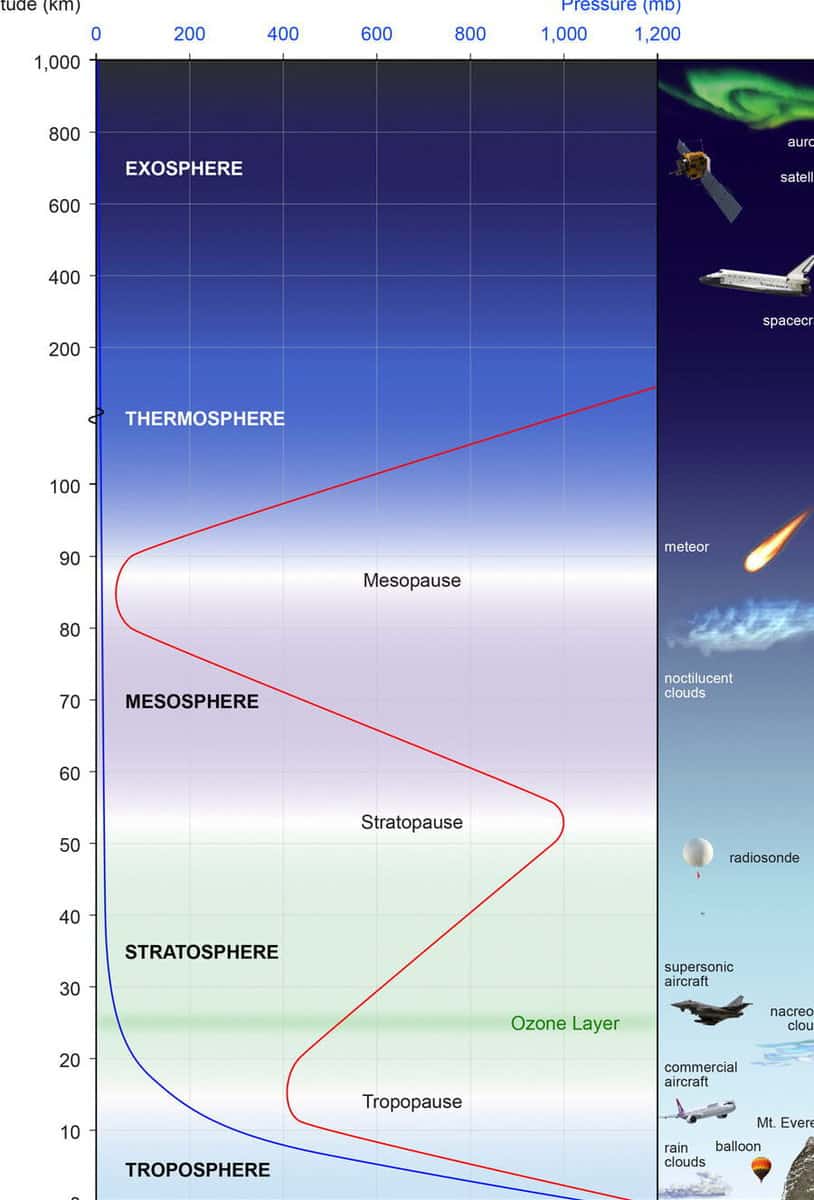The atmosphere of Earth consists of multiple layers of gases that envelop the planet due to the effects of gravitational field.
Each layer possesses a distinct gas composition and they are all arranged based on their density. Heavier gases are drawn closer to the surface of the Earth, while lighter gases reside further away from the planet.
Due to the unique characteristics of each gas, the atmosphere’s layers have their own attributes and fulfill specific roles in their interactions with the Earth.
There are a total of five layers that constitute the Earth’s atmosphere:
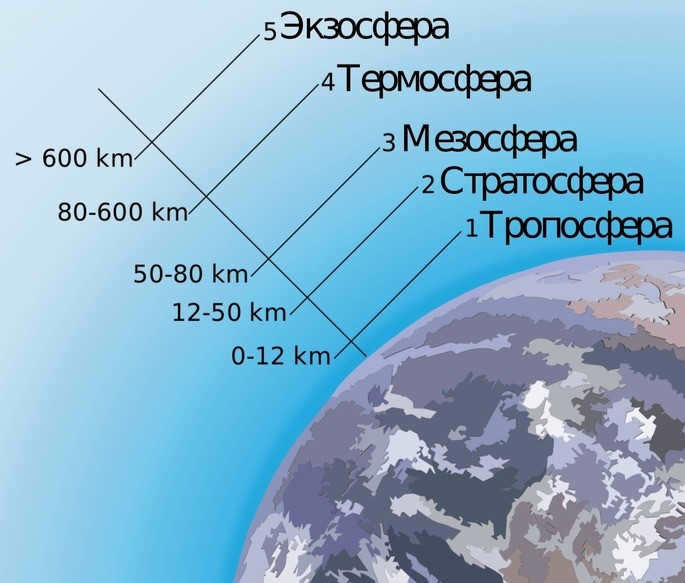

The Troposphere
The troposphere, which is the layer of the atmosphere closest to the Earth’s surface, is also the densest. It holds the majority of the atmosphere’s total mass, which is estimated to be around 5×1018 kg.
The thickness of the troposphere can vary, ranging from 8 km to 14 km, depending on the specific geographic region. The thinnest parts, measuring about 8 km in thickness, are typically found at the north and south poles.
Being the lowest layer of the atmosphere, the troposphere plays a crucial role in sustaining life on Earth and is the stage for almost all climatic events. The term “troposphere” is derived from the Greek word “tropos” which means “change”, highlighting the dynamic nature of climate change and the behavior of this atmospheric layer.
The boundary between the troposphere and the stratosphere, known as the tropopause, is characterized by distinct pressure distribution patterns and temperature variations in each layer.
Composition of the troposphere
The troposphere is primarily made up of nitrogen (78.08%), oxygen (20.95%), argon (0.93%), and carbon dioxide (0.04%) by volume. Additionally, the air in the troposphere contains varying amounts of water vapor, which enters the atmosphere through the process of evaporation.
Temperature in the troposphere
Similar to pressure, the temperature in the troposphere decreases as altitude increases. This is because the Earth’s surface absorbs more solar energy, resulting in the lower levels of the troposphere being heated. Warmer regions experience higher rates of evaporation, leading to a higher presence of water vapor at sea level and a lower presence at higher altitudes.
What can be observed in the troposphere?
There are various things that can be observed in the troposphere:
- The climate;
- Precipitation in the form of rain, snow, and hail;
- Gases like nitrogen, oxygen, argon, and carbon dioxide;
- Clouds;
- Birds.
Stratosphere
The stratosphere is the Earth’s second largest atmospheric layer and the second closest to the planet’s surface. It is estimated to contain approximately 15% of the total mass of the Earth’s atmosphere.
Spanning 35 km from the tropopause, the stratosphere is situated between the troposphere and the mesosphere. The term “stratosphere” originates from the Greek word “strato” which means “layer,” highlighting the fact that the stratosphere is further divided into thinner layers.
The presence of distinct stratospheric layers is a result of the absence of climatic phenomena that mix the air. This creates a clear separation between the cold, dense air below and the warm, light air above. Consequently, in terms of temperature, the stratosphere operates in direct contrast to the troposphere.
Due to the fact that it is an area with a higher level of vertical stability (where there is no movement of air), pilots of airplanes typically choose to remain in the lower part of the stratosphere in order to avoid experiencing turbulence. It is at this particular altitude that both airplanes and balloons are able to reach their peak level of performance.

The stratosphere is home to the famous ozone layer, which plays a crucial role in shielding us from the sun’s harmful ultraviolet radiation. Without this protective layer, life on Earth as we know it would simply not be possible.
Similar to the troposphere, the stratosphere also has a distinct boundary that marks the transition into the mesosphere. This boundary is known as the stratopause.
Structure of the stratosphere
The stratosphere is characterized by a distinct composition compared to the Earth’s surface and the troposphere. Instead of reaching the stratosphere, most elements typically undergo decomposition in the troposphere, are eliminated by sunlight, or are transported back to the Earth’s surface through rain or other forms of precipitation.
- Decomposition in the troposphere is a common fate for these elements.
- Exposure to sunlight can lead to their elimination.
- Rain or other forms of precipitation can bring them back to the Earth’s surface.
Due to the temperature inversion between the troposphere and the stratosphere, there is minimal exchange of air between these two layers. As a result, water vapor is present in negligible amounts in the stratosphere, making cloud formation extremely rare in this region.
When it comes to gases, the stratosphere is primarily composed of ozone found in the ozone layer. It is estimated that 90% of the total ozone in the atmosphere is located within this particular region. Moreover, the stratosphere also contains substances that are transported by volcanic eruptions, including nitrogen oxides, nitric acid, halogens, and more.
Temperature in the stratosphere
The temperature in the stratosphere rises as the altitude increases, starting at -51 °C at the lowest point known as the tropopause and reaching -3 °C at the highest point called the stratopause.
What exists in the stratosphere?
The stratosphere contains various elements and substances, including but not limited to:
Mesosphere
The mesosphere represents the uppermost layer of the Earth’s atmosphere where gases are still blended together and not segregated by their mass. It is regarded as the most challenging layer to investigate, resulting in limited verified information about it.
Situated between the stratosphere and the thermosphere, the mesosphere spans approximately 35 kilometers from the stratopause. Its name, “mesosphere,” is derived from the Greek term “mesos,” meaning “center,” as it occupies the third position among the five atmospheric layers.
The mesosphere remains elusive to meteosondes and aircraft due to their inability to reach the necessary altitudes. Similarly, satellites can only orbit above it, making it difficult to accurately measure the properties of this region.
Rockets are currently the only method of studying the mesosphere, gathering a significant amount of data during each mission.
The mesosphere is where celestial objects entering Earth’s atmosphere burn up, resulting in phenomena like meteor showers.

The mesosphere’s composition
The composition of the mesosphere is similar to the layers below in terms of oxygen, nitrogen, and carbon dioxide percentages. Unlike the stratosphere, the mesosphere experiences less water evaporation, which results in the transfer of some ozone to this layer.
In addition to the aforementioned gases, the mesosphere also contains materials from meteors that vaporize upon entering the atmosphere. Consequently, this layer is characterized by a relatively higher concentration of iron and other metals.
Mesospheric temperature variation
The temperature in the mesosphere decreases as altitude increases, starting at -3° C at the stratopause and reaching a frigid -143° C at the mesopause, which is the coldest area in the Earth’s atmosphere.
What exists in the mesosphere?
The mesosphere contains various elements and phenomena. Here are some examples:
Thermosphere
The thermosphere, positioned above the mesosphere and below the exosphere, spans a thickness of approximately 513 kilometers, surpassing the combined thickness of all the lower layers.
Even though the thermosphere is categorized as part of the Earth’s atmosphere, the air density is so sparse that the majority of this layer is often misconceived as outer space. This perception is reinforced by the insufficient number of molecules present in the thermosphere to transmit sound waves.
Within the thermosphere, the occurrence of photoionization arises due to ultraviolet radiation, wherein ions are formed when photons interact with atoms. This phenomenon is accountable for the formation of the ionosphere, which resides inside the thermosphere. The ionosphere plays a vital role in facilitating the propagation of radio waves to distant regions of the Earth.
The thermosphere is where satellites revolve around the International Space Station (ISS). Additionally, it is in this layer of the atmosphere that the phenomenon of the aurora borealis takes place.
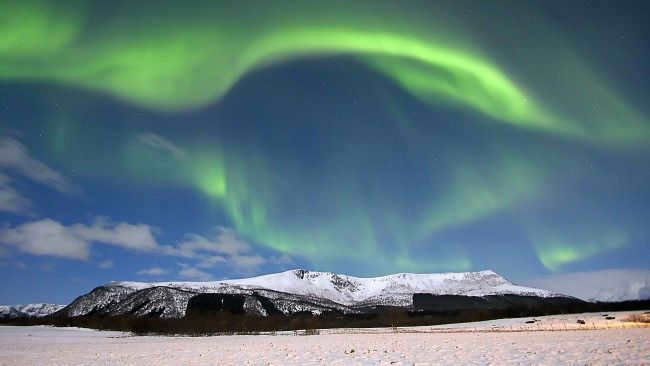

The term “thermosphere” is derived from the Greek word thermos, which means “heat,” indicating the high temperature in this region.
The border separating the thermosphere and the exosphere is known as the thermopause.
Structure of the thermosphere
In contrast to the lower layers, where gases mix together, the thermosphere is characterized by a lack of collisions between particles, which leads to a distinct separation of elements. Furthermore, the majority of molecules in the thermosphere are broken down by the effects of sunlight.
Within the higher regions of the thermosphere, one can find atomic oxygen, atomic nitrogen, and helium.
Temperature of the thermosphere
The temperature range in the thermosphere varies from 500º C to 2000º C. This wide temperature range can be attributed to the absorption of most of the sunlight in this particular layer.
What can be found in the thermosphere?
The thermosphere is home to various objects and phenomena, including:
- artificial satellites
- the Space Shuttle, a spacecraft designed for reusable transportation
- the International Space Station (ISS)
- the mesmerizing phenomenon of the northern lights
- the ionosphere
Exosphere
The exosphere is Earth’s largest and outermost layer of the atmosphere, extending up to 600 km before gradually transitioning into the vastness of interplanetary space. With a thickness of 10,000 km, it reaches halfway to the Moon, marking its farthest boundary.
The term “exosphere” derives from the Greek word “exo,” which means “outer,” highlighting its position as the final atmospheric layer before entering the cosmic vacuum.
Structure of the exosphere
The exosphere is characterized by particles that are widely dispersed and do not qualify as gases due to their extremely low density. In fact, these particles can travel vast distances of hundreds of kilometers before encountering another particle. It is important to note that these particles are not considered plasma as they lack electrical charge.
Within the lower regions of the exosphere, you can find elements such as hydrogen, helium, carbon dioxide, and atomic oxygen. Despite their minimal attraction to Earth caused by the gravitational field, these elements still exist in this part of the exosphere.
Temperature of the exosphere
Due to the lack of molecular interaction, the exosphere remains in a constant and cold temperature as it is almost a vacuum.
What can be found in the exosphere?
The exosphere contains various elements, including:
Atmospheres of other planets
Within our solar system, there are 8 planets and more than 160 satellites. Notably, the following have significant atmospheres:
- Earth;
- Venus;
- Saturn;
- Mars;
- Uranus;
- Jupiter;
- Neptune;
- Titan (a satellite of Saturn);
- Pluto (a dwarf planet).
Venus’ air composition
The air on Venus is composed of approximately 96% carbon dioxide, with a surface temperature of around 464°C. There are fast-moving clouds of sulfuric acid, traveling at about 100 meters per second.
The air on Mars
Mars has a thin atmosphere made up of roughly 95% carbon dioxide, with the remaining portion consisting of nitrogen and argon. The average air temperature on the Martian surface is -63°C. Clouds made of both water and carbon dioxide have been observed on Mars, and the planet experiences distinct seasons.
For more information on Earth, check out our articles on Singularity and Cosmology.

The term “atmosphere” refers to a “ball” and “vapor.” It is the gaseous envelope that surrounds our planet, Earth. However, it is not only Earth that possesses an atmosphere; other planets such as Mars, Venus, and Titan also have their own atmospheres.
The structure of Earth’s atmosphere is intricate, with each layer possessing its own unique characteristics and parameters.
Yet, it is on our home planet where the atmosphere is truly distinct. The space between the Troposphere, Stratosphere, Mesosphere, Thermosphere, and Exosphere contains transition zones known as “pauses,” where the temperature, density, and composition of the air gradually change. These zones are called “pauses.”
The formation of the atmosphere’s composition began approximately four billion years ago.

In the beginning, the atmosphere was primarily composed of hydrogen and helium. Over time, as volcanoes erupted, a gas shell formed and there was an exchange of gases with water, living organisms, and their byproducts. Oxygen production became more active thanks to the activity of cyanobacteria or blue-green algae. This led to a reorganization of the biosphere and eventually a global glaciation or oxygen catastrophe. The chemical composition gradually changed over several million years, resulting in the atmosphere we have today.
The earth’s atmosphere serves as a protective shield against the sun’s radiation and the entry of celestial bodies, causing them to burn up before reaching the planet’s surface. It extends approximately 1500 kilometers from the Earth’s surface and is primarily composed of nitrogen and oxygen, with trace amounts of carbon dioxide, water vapor, methane, hydrogen, neon, and other gases.
The physical state of the atmosphere is determined by climate and weather conditions, which are influenced by factors such as density, pressure, temperature, and composition.
One of the unique features of the Earth’s atmosphere is its abundant oxygen content, which gives the planet its distinctive blue halo. This oxygen is essential for the survival of animals and plants. However, human activities have led to significant changes in the atmosphere’s composition, posing a threat to the stability of our climate.
However, the exact mechanism by which oxygen disappears from the Earth’s atmosphere remains unclear. There is no consensus on this issue, and currently, there are a few hypotheses that are being considered.
One hypothesis suggests that the extraction of large amounts of rocks from the Earth’s surface leads to oxidation and increased erosion, which could contribute to the reduction of oxygen in the atmosphere.
Another hypothesis proposes that climate change, specifically a gradual decrease in temperature over millions of years, may be a factor. It is believed that this temperature decrease causes reactions that are linked together, leading to increased oxygen dissolution in the ocean. However, this is still just a conjecture that scientists are investigating and testing.
Despite the ongoing debate, D. Stolper asserts that humanity now consumes thousands of times more oxygen than in the past. This excessive oxygen consumption, coupled with the burning of thousands of tons of carbon, serves as evidence that the Earth’s processes are being accelerated to a significant extent due to the large population inhabiting the planet.
There is oxygen present in the atmosphere up to approximately one hundred and fifteen kilometers. At an altitude of five kilometers, many individuals, especially those who are untrained, experience oxygen deprivation. Breathing becomes extremely difficult at nine kilometers above sea level.
Without specialized equipment, a person cannot survive at a height of twenty kilometers above sea level. The pressure of water and carbon dioxide in the lungs remains constant, while the availability of oxygen gradually decreases. As a result, all bodily fluids will eventually boil.
The atmosphere is divided into five main layers, starting from the surface and moving upwards.
At the bottom of the atmosphere is the troposphere.
The first layer of the atmosphere is called the troposphere, and one of its notable features is a decrease in temperature every hundred meters by 0.65 degrees Celsius. At the top of the troposphere, the temperature is as low as -53 degrees Celsius. In addition to the temperature differences, there is also a horizontal stratification of air masses within this layer. These air masses vary in their place of formation and can give rise to anticyclones and cyclones at their boundaries, known as atmospheric fronts. These fronts play a crucial role in determining the weather patterns in a given area.
The troposphere is the most extensively studied layer of the atmosphere and extends from 8 to 12 kilometers in height. It is characterized by a high concentration of water vapor, which leads to the formation of numerous clouds. While there are still some water vapors present in the stratosphere and tropopause, their quantities are significantly lower, resulting in a lack of cloud formation in these regions.
Overall, the troposphere is the layer of the atmosphere that is most shielded from the Sun’s rays. It is also highly populated and dynamic, experiencing constant movement and changes.
Approximately 80% of the Earth’s atmosphere is occupied by the troposphere.
Recently, scientists made an interesting discovery about this particular layer of the atmosphere regarding temperature variations with altitude. Initially, they assumed that this temperature drop phenomenon applied to all layers of the atmosphere. Their explanation was that as one moves away from the sun-heated surface of the Earth, the temperature decreases. However, further investigations using atmospheric probes revealed a different pattern. It was found that the temperature decreases up to an altitude of ten kilometers, after which it remains constant and then gradually starts to warm up. These findings contradicted the scientists’ previous understanding of vertical temperature changes in the atmosphere. To verify their assumptions, they decided to launch balloons at night, when the devices would not be influenced by the sun’s heat.
However, the data remained unchanged: the temperature ceases to decrease as altitude increases. Scientists acknowledged the observation that beyond a certain height, the laws governing the atmosphere differ from those in the lower part.
The region where the temperature decreases is known as the troposphere, while the region where it remains constant is referred to as the stratosphere.
Stratosphere: The Second Layer of the Atmosphere
Situated above the troposphere and below the mesosphere, the stratosphere is the second layer of the Earth’s atmosphere. It spans from 8 to 55 kilometers above the planet’s surface. The stratosphere shares a similar composition with the troposphere, although it is characterized by higher levels of ozone and lower levels of water vapor. As altitude increases, so does the temperature, primarily due to solar radiation rather than the movement of air masses.
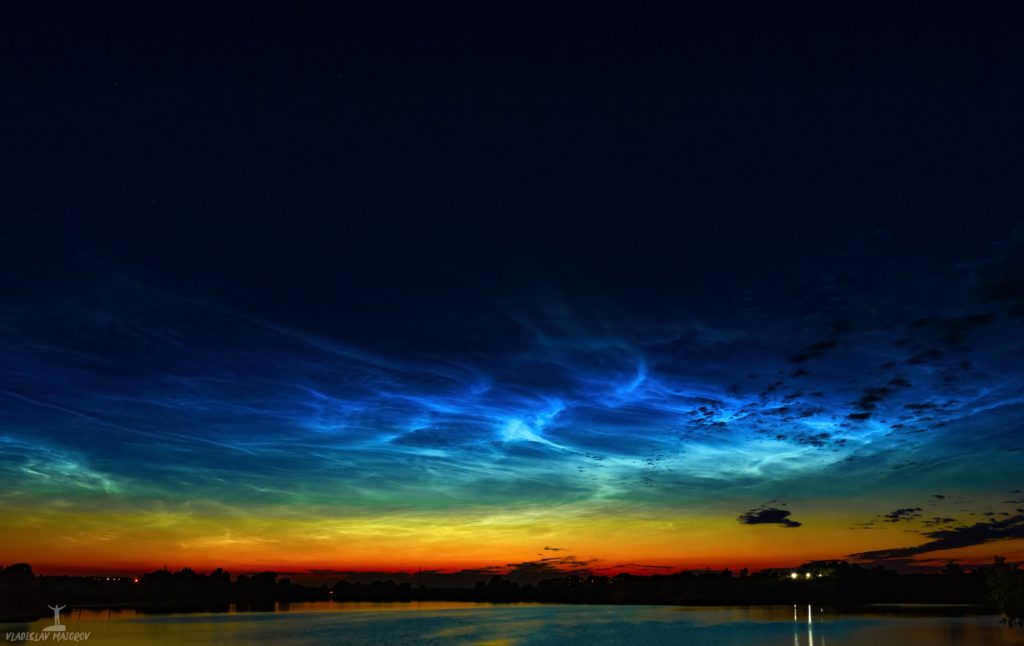
The air masses in this region move in a parallel manner.
The stratosphere acts as a barrier, preventing ultraviolet radiation from reaching the Earth’s surface and instead converting it into shorter waves. These waves have an impact on ionization, molecular decay, and alterations in magnetic fields. As a result, we are able to witness phenomena such as fireworks, the aurora borealis, and nacreous clouds.
The stratosphere is a common route for airplanes and balloons to traverse.
The stratosphere is home to the ozone layer, which sets the boundary for life in the biosphere. Ozone absorbs ultraviolet radiation and warms the air. Free radicals, freons, and nitrogen oxide destroy ozone through contact, resulting in the formation of A through a chemical reaction.
Ozone plays a critical role in shaping life on Earth. In 1985, scientists uncovered a depletion in the ozone layer over Antarctica and the Arctic, which has significant implications for climate. The expansion of the ozone hole leads to both warming and cooling effects.
The mesosphere is the third layer of the atmosphere
Located above the stratosphere, the mesosphere extends up to 80 km from the Earth. This layer is known for its extremely low temperatures, dropping to as low as -90 degrees. In fact, the mesosphere is considered the coldest region of the atmosphere, with temperatures sometimes reaching -143 degrees.
In terms of composition, the mesosphere consists of a combination of 80% nitrogen and 20% oxygen. The thinness of the air in this layer makes it difficult for aircraft to navigate through it. However, for space structures, the denser air in the mesosphere is actually beneficial.
Occasionally, there can be sightings of silver-hued clouds composed of ice crystals. These clouds are pale, see-through, and weightless. Researchers have been studying these types of clouds for over a century. They were first documented in the summer of 1885. Typically, they manifest in the northern hemisphere between May and August. However, in 2013, these clouds were spotted over Europe in February and March during sunset. Residents of England, Norway, Denmark, the Moscow Region, and Lithuania were fortunate enough to witness this phenomenon.
The thermosphere: the fourth layer of the atmosphere
The thermosphere, which is the fourth layer of the atmosphere, extends up to 800 km. In this layer, the density of the air decreases while the temperature increases. The thermosphere is also known as the ionosphere, as it is characterized by strong ionization. This ionization leads to the phenomenon of the northern lights. Occasionally, the thickness of the thermosphere decreases due to low solar activity.
This layer serves as a transitional zone into outer space. It is within the thermosphere that spaceships navigate through the vastness of space. Because the air density is low in this region, objects like satellites do not experience heating.
The exosphere: the uppermost layer of the atmosphere
The exosphere, situated approximately 800 kilometers above the Earth’s surface, is known as the uppermost layer of the atmosphere. The term “exosphere” originates from the Greek word “exo,” meaning “outside.” In this region, the air is exceptionally thin and rarified, and the temperature experiences minimal changes as altitude increases. It is at this boundary that gases have the ability to escape, defying gravity and venturing into outer space. When helium and hydrogen particles combine, a captivating corona-like glow is produced.
Due to the lack of interaction between the particles of the exosphere and those originating from the Earth, there is no heat exchange in this layer.
The exosphere plays a significant role in influencing the Earth’s magnetic field. It is home to the radiation belts and is predominantly composed of ionized hydrogen.
The Boundary of Space: The Karman Line
The Karman line is the boundary that separates the Earth’s atmosphere from space. It is located at an altitude of one hundred kilometers above sea level and marks the upper limit of any atmospheric state.
Theodore von Karman was the first to discover that the air at this altitude becomes so thin that it is impossible for conventional aircraft to fly. The velocity required to achieve lift exceeds the threshold for reaching space, thus necessitating the use of astronautics.
The Karman Line is officially recognized by the International Space Federation as the boundary of space. Beyond this line, the atmosphere transitions into the vastness of outer space.
In 1944, a ballistic missile became the first man-made object to cross the Karman Line, reaching an altitude of 188 kilometers.
Out of all the organisms that have ventured above the designated line, it was the Drosophila fly that first achieved this feat. These flies were sent into space by the United States in the year 1947. In terms of mammals, the macaque monkey named Albert-2 was the first to surpass this line in 1949. However, it was the dogs Tsygan and Desik, who were launched by the Soviet Union in 1951, that managed to not only cross the line but also return back to Earth.
Once an artificial vehicle breaches this symbolic boundary, the flight is officially considered a space flight.

At an elevation of one hundred kilometers, sound cannot travel and the principles of aerodynamics do not apply. Heat cannot be transferred through any other means, only via thermal radiation. Unlike the lower atmosphere, there is no convection or air mixing.
The intermediate layers of the atmosphere – tropopause, stratopause, mesopause, thermopause
The tropopause, stratopause, mesopause, and thermopause exist between the atmospheric layers, acting as boundaries between them.
The tropopause ranges in size from one to two kilometers. The temperature is higher in summer than in winter, although a consistent temperature of minus seventy degrees is maintained over the equator and minus sixty-five degrees over the Earth’s poles.
The stratopause is located between the stratosphere and the mesopause, at an elevation of approximately fifty-five kilometers. At this level, the temperature drops to zero degrees, and the air becomes highly rarefied, making it impossible to breathe. Additionally, the pressure is significantly lower, being 1,000 times less than at sea level.
Similar layering and temperature fluctuations can be observed on other planets that possess atmospheres.
The mesopause is one of the thinnest layers, measuring around five kilometers in thickness. It is situated at an altitude of 90 kilometers and acts as a boundary between the mesosphere and the thermosphere.
The temperature within the mesopause can reach as low as -100 degrees. As a transitional zone, the pressure and composition of this layer remain consistent with those of the adjacent layers.
Occasionally, silvery clouds can be found in this intermediate layer, and they can be utilized to determine the wind velocity at a particular altitude, which can reach speeds of up to 100 m/s.
The thermopause is a transitional zone situated between the thermosphere and exosphere in the Earth’s atmosphere. It lacks well-defined boundaries, as it represents a layer where the temperature remains relatively constant, fluctuating between 250 and 1500C. The approximate altitude range for this layer is up to 800 km.
Due to the extremely thin air density and the presence of radiation belts caused by solar radiation, even unmanned aerial vehicles are unable to navigate through this region.
Observing the atmosphere allows for monitoring weather, climate, and their fluctuations. These disciplines, known as climatology and meteorology, involve the study of various factors such as humidity, atmospheric pressure, temperature, wind speed, and other relevant indicators. By analyzing this data, meteorologists and climatologists can accurately predict atmospheric phenomena such as thunderstorms, rain, tornadoes, fog, and more.
The atmosphere refers to the Earth’s air envelope that rotates alongside it.
The lower boundary of the atmosphere aligns with the Earth’s surface, as air can penetrate the tiniest pores in the soil and even dissolve in water.
The upper boundary gradually transitions into outer space at an altitude of 1000-2000-3000 km.
Significance of the atmosphere
- The atmosphere plays a crucial role in supporting life on Earth by providing oxygen. This essential gas is utilized in the process of respiration by humans, animals, and plants.
- Without the atmosphere, Earth would be as silent as the moon since sound is the result of air particle vibrations.
- The atmosphere acts as a shield against the harmful ultraviolet radiation emitted by the Sun, which can be detrimental to living organisms.
- By trapping heat near the Earth’s surface, the atmosphere helps to maintain a stable temperature and prevents our planet from cooling excessively.
- The atmosphere also serves as a protective barrier against meteorites, shielding the Earth’s surface from potential impacts.
- Furthermore, the atmosphere enables the weathering of rocks, contributing to the geological processes that shape our planet.
Composition of the atmosphere
The atmosphere is composed of multiple layers that vary in temperature and density, as shown in Figure 1.
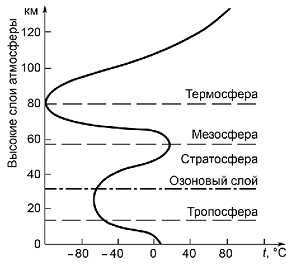
Figure 1. Structure of Earth’s atmosphere
Troposphere
Troposphere is the lowest and most dense layer of the atmosphere.
The troposphere is the most conducive to life. It is the habitat of the majority of Earth’s living organisms, including humans.
The atmosphere rotates with the planet, resulting in a similar flattening at the poles. The upper boundary of the troposphere is 16-18 km above the equator, 10-12 km at temperate latitudes, and 8-9 km above the poles.
The troposphere contains 80% of the air mass, nearly all water vapor, and impurities.
In the troposphere, various movements of air occur, such as horizontal and vertical motions. These movements are responsible for the formation of clouds and the occurrence of atmospheric precipitation, including rain, snow, and other types. It can be said that the weather primarily originates in the troposphere. The lower layer of the atmosphere is warmed by the Earth’s surface, but as the air ascends, its temperature gradually decreases. At the upper limit of the troposphere, the air temperature reaches as low as -50 °C.
Stratosphere
The stratosphere is the Earth’s second layer from the surface.
It extends up to a height of 50-55 km.
The air in the stratosphere is rarefied, making it impossible to breathe.
As you ascend in the stratosphere, the air temperature rises, and at the upper boundary, it almost reaches 0°C.
Between 20-25 kilometers, there is the ozone layer. This layer acts as a shield, protecting all life on Earth from harmful ultraviolet rays. However, due to the emissions from fuel combustion and the use of freons, the ozone layer is being destroyed, resulting in the formation of ozone holes (such as the one over Antarctica).
Above 50-55 kilometers, there are the upper layers of the atmosphere: mesosphere, thermosphere, and exosphere.
The air density in these layers is almost non-existent. Incredible natural events take place here: auroras (the shimmering lights caused by thin gases) and shooting stars (the bursts of meteoroids burning up in the air). The exosphere is the region where hydrogen, oxygen, and helium manage to escape into the vastness of space.
Mesosphere
Mesosphere is a region in the Earth’s atmosphere that extends from about 50 to 80 kilometers above the surface.
At this altitude, the air is about 200 times less dense than at sea level. The mesosphere is known for its dark appearance, making the sky appear black. Even during the day, stars can be seen in the mesosphere. The temperature in the mesosphere can drop as low as -75 (-90)°C.
Thermosphere
At 80 kilometers above the Earth’s surface, the thermosphere begins.
In this layer, the temperature of the air increases dramatically up to a height of 250 meters, and then remains constant: at 150 kilometers above the Earth, it reaches temperatures of 220-240 degrees Celsius; at 500-600 kilometers above the Earth, it exceeds temperatures of 1500 degrees Celsius.
In the mesosphere and thermosphere, due to the impact of cosmic rays, gas molecules break down into charged (ionized) particles, resulting in this part of the atmosphere being known as the ionosphere – a layer of very thin air located between 50 and 1000 kilometers above the Earth’s surface. It is primarily composed of ionized oxygen atoms, nitrous oxide molecules, and free electrons. This layer is highly electrified and acts as a mirror, reflecting long and medium radio waves.
In the ionosphere, there are auroras – the luminous phenomenon caused by rarefied gases reacting to electrically charged particles emitted from the Sun – and there are also noticeable variations in the magnetic field.
Exosphere
Exosphere refers to the outermost layer of the atmosphere, extending beyond 1000 km above the Earth’s surface.
This region is also known as the scattering sphere due to the high velocity movement of gas particles, which can scatter into outer space.
Composition of the atmosphere
The atmosphere is made up of different gases. Nitrogen is the most abundant gas, making up about 78% of the atmosphere. It is an important component of proteins. Oxygen is the second most abundant gas, making up about 21% of the atmosphere. Other gases make up the remaining 1%. Carbon dioxide is a small but significant component, making up about 0.03% of the atmosphere. Oxygen, specifically, makes up about one-fifth of the air.
The atmosphere is a mixture of various gases. It consists of nitrogen (78.08%), oxygen (20.95%), carbon dioxide (0.03%), argon (0.93%), as well as small amounts of helium, neon, xenon, krypton (0.01%), ozone, and other gases. However, the content of these other gases is negligible.
Role
The atmosphere plays various important roles, with the main significance lying in its ability to strongly absorb radiant energy. This absorption has a significant impact on the temperature of the Earth’s surface and atmosphere.
Table 1: Composition of dry atmospheric air near the Earth’s surface
NitrogenNitrogen is the most abundant gas in the atmosphere and has low reactivity.
OxygenOxygen, in contrast to nitrogen, is a highly reactive element. Its specific function is to oxidize organic matter produced by heterotrophic organisms, rocks, and under-oxidized gases emitted by volcanoes. The presence of oxygen is crucial for the decomposition of dead organic matter.
Carbon dioxide plays a crucial role in the Earth’s atmosphere. It is released into the air through various processes such as combustion, respiration, and decay. Furthermore, carbon dioxide is the primary component used for the production of organic matter during photosynthesis. Another significant aspect of carbon dioxide is its ability to both transmit short-wave solar radiation and absorb a portion of the long-wave thermal radiation. This phenomenon, known as the greenhouse effect, will be further explained later on.
The ozone has a significant influence on atmospheric processes, particularly on the thermal state of the stratosphere. This natural gas acts as a UV radiation absorber emitted by the Sun, and as a result, the absorbed solar radiation causes the air to heat up. The total ozone content in the atmosphere varies on a monthly basis, depending on the geographical latitude and time of the year. It typically ranges from 0.23-0.52 cm, representing the thickness of the ozone layer at ground pressure and temperature. The ozone content increases from the equator towards the poles and follows an annual cycle with a minimum in the autumn and a maximum in the spring.
An important characteristic of the atmosphere is that the concentration of the primary gases (nitrogen, oxygen, argon) remains relatively constant with increasing altitude: at an elevation of 65 km in the atmosphere, nitrogen comprises 86% of the gases, oxygen – 19%, argon – 0.91%, whereas at an elevation of 95 km, nitrogen makes up 77%, oxygen – 21.3%, argon – 0.82%. The consistency in the composition of atmospheric air is maintained both vertically and horizontally through mixing.
Besides gases, the air also contains water vapor and particles. These particles can originate from natural sources as well as human activities. Examples include flower pollen, small salt crystals, dust from roads, and aerosol pollutants. When sunlight enters a room, these particles can be visible to the naked eye.
There is a significant amount of particulate matter present in the air of urban areas and major industrial centers. This is due to the emissions of harmful gases and impurities that are produced during the combustion of fuel, which then combine with aerosols.
The level of aerosols in the atmosphere plays a role in determining the clarity of the air, which in turn affects the amount of solar radiation that reaches the Earth’s surface. One of the largest types of aerosols is condensation nuclei, which are responsible for the conversion of water vapor into water droplets.
Greetings, valued readers of the KtoNaNovenkogo.ru blog.
Many celestial bodies, including almost all of the planets in our solar system, possess atmospheres. However, we are particularly interested in the Earth’s atmosphere, as it is the environment in which we reside.
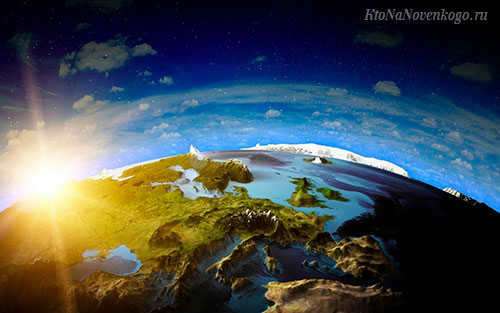
Today, we will be discussing the concept of the atmosphere, its composition, structure, and the distinct layers that make it up. Join us for an intriguing exploration of this fascinating topic.
Atmosphere Explained
The term “atmosphere” originates from ancient Greek, specifically from the words “atmos” meaning vapor and “sphere”. In its simplest definition, it refers to the gaseous envelope that surrounds any celestial body due to the force of gravity.
Distinguishing between a planet’s atmosphere and outer space is not straightforward, thus the atmosphere is commonly regarded as a gaseous medium that rotates along with the celestial body as a whole.
The Earth’s atmosphere stretches up to 800 kilometers above sea level. Nevertheless, the recognized boundary with space, as designated by the International Aviation Federation (FAI), is situated at an altitude of 100 kilometers above sea level and is known as the Karman Line.
It is common knowledge that the Earth has an atmosphere (which will be further discussed).
However, what I am referring to is the fact that besides the Earth, the Sun also possesses an atmosphere (how?) and eight (out of nine) planets in the solar system (with only Mercury being an exception), which is likely unknown to many.
If one were to delve even deeper, Saturn’s moon Titan should be added to this group, as it has a rather dense atmosphere (while other moons, including the Moon, have such a thin gas shell that it cannot be considered a complete atmosphere).
Each atmosphere has its own unique chemical composition and behavior.
For instance, the atmospheres of the neighboring planets Venus and Mars consist primarily of carbon dioxide (CO2) with traces of nitrogen, oxygen, argon, and other gases.
The temperature and pressure of these planets are primarily influenced by their mass and distance from the Sun. Specifically, Venus has an average surface temperature of approximately 450 degrees Celsius and a pressure of 90 bar. On the other hand, Mars has an average surface temperature of -25 degrees Celsius and a pressure of 6 mbar, which is only 0.6% of Earth’s pressure.
In the case of gas giants like Jupiter, Saturn, Uranus, and Neptune, their atmospheres are mainly composed of hydrogen and helium. These gases are supplemented by various impurities such as ammonia, methane, phosphorus, sulfur, and others, which contribute to their distinct colors when observed through a telescope.
Earth’s atmosphere composition
The composition of Earth’s atmosphere is presented in the table below, based on information from Wikipedia:
| Nitrogen (N) | 78.1 | 75.5 |
| Oxygen (O) | 20.9 | 23.1 |
| Argon (Ar) | 0.9 | 1.3 |
| Carbon dioxide (CO2) | 0.04 | 0.05 |
| Other gases (neon, helium, etc.) | 0.06 | 0.05 |
Arrangement and divisions of Earth’s atmospheric layers
The atmospheric column of our planet is categorized into the subsequent layers:
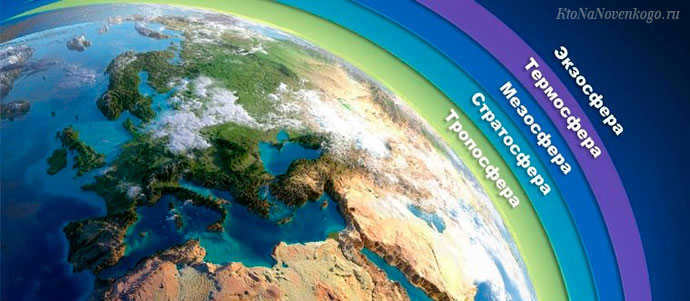
The Troposphere stretches to an altitude of 8 to 18 km, depending on the geographical latitude and time of the year. The thinnest layer can be found in polar latitudes, while the thickest layer is found in tropical latitudes. The thickness of the troposphere decreases during the winter and increases during the summer.
The lower (boundary) layer, which extends to a height of 1-2 km, contains approximately 80% of the total mass of atmospheric air and nearly 90% of the water vapor.
Within the troposphere, turbulent and convective air flows are constantly formed due to temperature differences (which can reach 100 degrees Celsius) and pressure. This leads to the formation of clouds, cyclones, anticyclones, and other atmospheric phenomena that contribute to the formation of weather conditions.
The stratosphere is situated at an altitude ranging from 12 to 50 kilometers. Its noteworthy characteristic is the fact that the temperature remains relatively stable in the lower layer (between 12 and 25 km) and then starts to increase (from -50 to 0 degrees Celsius).
In the middle layers of the stratosphere, there exists the ozone layer which acts as a protective shield for the Earth against ultraviolet rays.
The gas envelope located below the ozone shield constitutes the biosphere, a term referring to the sum total of all ecosystems on Earth. The composition and structure of the biosphere are greatly influenced by living organisms. The stratosphere contains approximately 20% of the total mass of the atmosphere. At times, it forms delicate iridescent clouds that are occasionally visible during sunset.
The mesosphere starts at an altitude of 45-50 km and extends up to 85-90 km. Within the mesosphere, the temperature progressively decreases (from 0 to -100 o C) with an average gradient of 0.3 o C for every 100 m. Additionally, active radiant heat exchange and photochemical processes occur in this layer.
Similar to the stratosphere, the mesosphere contains a small amount of water vapor, which is sufficient for the formation of the highest clouds known as silvery clouds.
However, the mesosphere is not suitable for flight due to the thinness of the air for airplanes and the density for spacecraft.
The thermosphere, on the other hand, has its upper boundary at altitudes ranging from 500 to 800 km. This layer experiences a continuous temperature increase (ranging from -100 to +1200 o C!) over a thickness of five hundred kilometers. Once this temperature rise stabilizes, it remains almost constant over a vast area.
The ionization of air takes place in the troposphere, which is the main part of the ionosphere. At higher altitudes, there is a predominance of atomic oxygen.
During periods of low solar activity, the thermosphere significantly decreases in size. Solar activity follows a cyclic pattern with a duration of 11 years.
The exosphere is the outermost layer of the atmosphere, located above the 500 km mark. It is extremely rarefied and has high temperatures, reaching up to 2500°C due to intense solar radiation. Gas particles from the exosphere gradually dissipate into interplanetary space, leading to a gradual thinning of the atmosphere as a whole.
The transition from one layer of the atmosphere to another occurs smoothly, with intermediate stages such as the tropopause between the troposphere and stratosphere.
- The stratopause is located between the stratosphere and the mesosphere.
- The mesopause is found between the mesosphere and the thermosphere.
- The thermopause marks the boundary between the thermosphere and the exosphere.
Environmental Pollution
The Earth’s atmosphere is heavily impacted by human economic activities, leading to environmental degradation, climate change, and other detrimental effects.
The Issue of Air Pollution The problem of air pollution is becoming increasingly concerning for both scientists and the general public.
Society is taking steps to improve the situation by reducing harmful emissions, constructing treatment facilities, transitioning to renewable energy sources, and implementing other measures. Only time will tell if these efforts will successfully reverse the worrying trend.
Best of luck to you! We hope to see you again soon on the KtoNaNovenkogo.ru blog.
This article falls under the following categories:
Comments and feedback (1)
It is fortunate that our planet is of sufficient size to maintain its atmosphere, and the Earth’s core generates a magnetic field that additionally shields our atmosphere from the solar wind, which eradicated nearly the entirety of Mars’ atmosphere.
We welcome any comments or feedback you may have.




The Earth’s atmosphere is a protective layer of gases that surrounds the planet and is held in place by gravity.
The atmosphere of the Earth has unique characteristics and properties.
Characteristics and Properties of Earth’s Atmosphere and Its Importance for Life:
The Earth’s atmosphere, which is held around the planet by gravity, is a gaseous envelope. Its name is derived from the ancient Greek words ἀτμός, meaning “vapor,” and σφαῖρα, meaning “sphere.” The atmosphere is considered to extend from the Earth’s surface to interplanetary space, although the boundary between the two is not clearly defined. This envelope of gases surrounds the Earth for hundreds of kilometers above its surface.
In the field of astronomy, the atmosphere refers to the gaseous envelope that surrounds any celestial body and moves along with it as it rotates on its axis. Almost all large celestial bodies, especially those composed of gases or similar in structure to Earth, such as Mercury, Venus, the Moon, Mars, Jupiter, Io, Europa, Ganymede, Callisto, Saturn, Enceladus, Titan, Rhea, Uranus, Neptune, Triton, Pluto, and others, possess a distinct atmosphere with a specific mass.
The specific mass of Earth’s atmosphere is 5.2×10^18 kilograms and it extends to a height of approximately 1000 kilometers. Earth’s atmosphere is volatile and subject to constant changes, with human activities being considered as the main driving force behind these changes.
The key characteristics of Earth’s atmosphere include:
– The movement of massive amounts of air in all layers, caused by differences in pressure due to the heating of gases, is known as high dynamism.
– Physical heterogeneity refers to the presence of various spheres and layers, each with its own unique physical characteristics.
– This system is highly vulnerable to biological factors and can easily become polluted by harmful substances such as gases, organic and inorganic particles, and biological molecules.
– Atmospheric pressure is a physical quantity that is created by the gravitational attraction of air to the planet and decreases as you move away from its surface.
One of the main functions of the atmosphere is to shield and safeguard the Earth and all living beings from various cosmic threats. It acts as a protective shield, causing small meteors to burn up upon entry, while larger meteors break apart into smaller fragments that pose less harm to the planet. Moreover, the ozone layer within the atmosphere acts as a filter, blocking harmful ultraviolet radiation from the sun and converting it into heat and light that is safe for sustaining life. Additionally, the atmosphere plays a crucial role in maintaining a comfortable temperature for human habitation on the planet’s surface, as well as facilitating the water cycle and air currents, both of which are essential for creating the necessary levels of humidity and temperature for the natural world to thrive.
The exploration and study of the Earth’s atmosphere have been and continue to be conducted through the use of meteoprobes.
Composition, Arrangement, and Strata of the Atmosphere:
The Earth’s atmospheric shield consists of five primary strata that begin at or below sea level and stretch into outer space. Interspersed throughout these strata are transitional regions, known as “pauses,” where the composition, density, and temperature of air masses undergo alterations. There exist four of these transitional regions, resulting in a total of nine layers within the atmosphere.
Troposphere:
The troposphere is the initial and lowest layer of the atmosphere, referred to as the “bottom” layer, which supports all forms of life on Earth including humans, animals, and plants. The troposphere spans several kilometers in height, ranging from 8-10 km near the poles to 18 km near the equator. This variation in atmospheric height is influenced by the Earth’s centrifugal force and its elliptical shape, resulting in different widths across different regions. Additionally, the season and temperature regime also play a role in the size of the troposphere. During the warm season, air masses rise to greater heights, while in the cold season they descend to the planet’s surface, thus expanding or contracting the width of the troposphere.
The troposphere derives its name from the ancient Greek words τρόπος – “turn, change” and σφαῖρα – “ball”. The initial component of the term perfectly aligns with the fundamental characteristics of the troposphere – its mobility, variability, and dynamism, which give rise to the various phenomena commonly referred to as “climate” and “weather”. These encompass:
– the development of cyclones and anticyclones;
The troposphere, being the heaviest layer, contains the majority of the atmosphere’s mass, about 80%. Additionally, it holds approximately 50% of all gases and nearly all moisture, providing the necessary elements for breathing to the inhabitants of the troposphere. Moreover, it acts as a heat retainer, trapping the solar rays absorbed by the Earth. This results in a decrease in pressure and temperature as one moves away from the troposphere’s surface. Specifically, the temperature decreases by 0.5-0.7 degrees Celsius for every 100 meters of ascent. Furthermore, wind speed also increases with altitude, with a 2-3 km/s increase for every kilometer of elevation. It is important to note that the temperature decrease is only characteristic of the lower layer (troposphere), whereas in all other layers, the temperature increases as one approaches the upper boundaries.
Near the lithosphere, there is an additional hindrance known as the surface boundary layer, which plays a crucial role in the circulation of the entire atmosphere. This layer is responsible for the emission of heat energy and radiation from the planet, as well as the creation of pressure differences and wind currents. These wind currents are subsequently influenced and directed by surface irregularities such as mountains and rocks.
The tropopause marks the upper boundary of the troposphere and serves as an intermediary barrier between the troposphere and the next atmospheric layer, the stratosphere.
The lower boundary of the troposphere is typically characterized by a normal pressure of 1000 millibars, which is very close to the standard pressure of 1013 millibars (equivalent to one “atmosphere”). As for the upper layer, the pressure increases to 200 mBar, and at a distance of 45 km above sea level, it decreases to 1 mBar.
The stratosphere is the layer of the atmosphere that follows the troposphere and tropopause. Unlike the tropopause, in the stratosphere, the temperature does not decrease with increasing altitude.
Stratosphere:
The stratosphere is positioned at altitudes ranging from approximately 10 km (at the north and south poles) or about 18 km (near the equator) up to 50 km above the sea level. The term originates from the ancient Greek word stratum, which means “planking, layer”. The pressure at the lower boundary is 10 times lower than at the Earth’s surface, while at the upper boundary it is nearly 1000 times lower. The stratosphere itself is highly rarefied, and it contains almost no moisture. The temperature of this layer increases as it approaches the mesosphere: at the boundary with the tropopause, it reaches -56.5 degrees Celsius, and closer to the upper limit, it ranges from 0 to +0.8 degrees Celsius.
The stratosphere is followed by the stratopause and then the mesosphere. In the stratopause, the heating of air masses ceases, and the temperature stops rising.
Another layer, known as the ozone layer, exists at the edges of the stratosphere. This layer plays a crucial role in safeguarding the Earth’s surface from the harmful impacts of ultraviolet rays.
The Importance of the Ozone Layer:
The ozone layer acts as a vital shield for life on our planet. Beyond its boundaries, various essential factors such as temperature, pressure, and cosmic radiation can annihilate all living organisms, including the most resilient forms of bacteria.
The presence of this protective barrier in the atmosphere can be attributed to two main factors:
– The abundant oxygen produced by the diverse plant life found across the globe;
– Ultraviolet is a chemical reactant for oxygen, resulting in the production of O gas3 – ozone, an interesting irony where ultraviolet waves are destroyed while also providing protection against them. One of ozone’s remarkable properties is its capacity to reflect the sun’s rays, generating warmth in its surroundings.
Mesosphere:
Mesosphere – An atmospheric layer situated between 40-50 and 80-90 kilometers above sea level. It is characterized by:
– Cold temperatures – temperatures at the upper boundary can drop as low as -80 degrees Celsius, while temperatures at the lower boundary are around 0 degrees Celsius;
– Extremely low gas pressure (tens of thousands of times lower than surface pressure);
– Lack of air mass movement due to their minimal (almost non-existent) lifting force.
The study of the mesosphere is hindered by similar factors: the limited availability of aircraft capable of navigating such extreme conditions hampers comprehensive exploration. Nevertheless, it is widely recognized that the mesosphere plays a crucial role in shielding the Earth from the impact of celestial objects, particularly meteors. While smaller meteors disintegrate and disperse as they enter this layer, larger ones occasionally manage to reach the planet’s surface, although they are already “burned out” and incapable of inflicting significant damage.
Following the mesosphere is the mesopause, which in turn transitions into the thermosphere. The mesopause represents the region of lowest temperature, measuring around -100 °C.
Thermosphere:
The thermosphere begins at an altitude of approximately 80-90 km. At an altitude of 100 km, the Karman line marks the boundary between Earth’s surface and outer space. Beyond the Karman line, atmospheric gases are virtually nonexistent. The thermosphere, the fourth layer of the atmosphere, is believed to start from this line. Its boundaries stretch up to 800 kilometers above sea level, and temperatures at its highest point can reach 1700 degrees Celsius.
Spacecraft made of metal, which starts to liquefy at a temperature of 1560 degrees Celsius, travel through outer space and return to Earth, easily surpassing this layer. This is because the thermosphere has an extremely low amount of gas and consequently low pressure, which is a million times less than on the Earth’s surface. The particles in this layer have high energy, but since the distance between the particles is vast, any space objects that fly through this layer are practically in a vacuum. This is why the thermosphere is selected as the location for satellites and orbital stations.
Due to solar radiation and cosmic radiation in the thermosphere, the air becomes ionized and results in the formation of “auroras”.
The thermosphere is followed by the “thermopause” and then the exosphere.
In the thermopause, solar radiation absorption is minimal, and there is no significant change in temperature with altitude. Additionally, polar auroras can be observed in this region.
Exosphere:
The exosphere is the uppermost layer of the atmosphere, beginning at approximately 800 km above sea level. Its name is derived from the Greek word “exo” which means “outside, beyond”. This layer is extremely rarefied and primarily consists of hydrogen atoms, the lightest chemical element. While nitrogen and oxygen atoms are also present, they become highly ionized due to ultraviolet radiation. Polar lights can also be observed in the exosphere.
The exosphere is the largest layer of the atmosphere in terms of size, with its boundaries extending hundreds of kilometers into space and encompassing the upper geocorona of the Earth. In this layer, gas atoms are extremely scarce, with their concentration being millions of times lower than that of Earth’s air.
Composition of the Atmosphere. Gases and other substances:
All layers of the atmosphere consist of various gases, although their concentrations vary. The air that all living creatures on Earth breathe contains the majority of the gases found in the atmosphere, accounting for nearly 80%. While there are 12 elements that have the highest concentration in the atmosphere, the entire periodic table of elements is present in the atmosphere in varying proportions. However, this composition has not always been the same.
The initial gases surrounding the Earth and characteristic of all gas giants were helium and hydrogen. These elements are the remnants of the nebula that gave rise to the most radiant star in our galaxy – the Sun, and settled in large quantities around the planet’s gravitational field.
The planet itself contained various other substances:
Volcanic eruptions and tectonic plate movements caused the release of these substances into the Earth’s developing atmosphere. Ammonia and methane were released from the subsurface, leading to their decomposition and the formation of other compounds, including nitrogen, which currently makes up 78% of the atmosphere. Oxygen played a crucial role in making the atmosphere suitable for supporting life.
There were several ways in which it emerged: large volumes of gases were ejected from the hot mantle of the Earth, and water vapor from volcanic eruptions decayed under direct sunlight to form hydrogen and oxygen. However, it was not possible to retain oxygen in the atmosphere as it underwent further chemical reactions and underwent modifications.
The Earth’s atmosphere was able to accumulate sufficient quantities of oxygen thanks to the emergence of biological organisms that excrete it during their life processes. This led to:
– Achieving an oxygen concentration of 21% in just two billion years;
– Significantly reducing the concentration of carbon dioxide by incorporating it into their own bone tissue;
– The formation of an ozone layer is crucial for the protection of living organisms against damaging ultraviolet light.
In addition to the primary gases – hydrogen, oxygen, and carbon dioxide – the atmosphere contains noble gases:
Noble gases are produced through nuclear processes deep within the Earth’s crust and are released into the atmosphere through microfractures in the lithosphere or volcanic eruptions.
Water is also present in the atmosphere, with its concentration depending on latitude: at the poles, it is 0.2%, while at the equator, it reaches 2.5%. Various nitrogen oxides, propane, and radon are also found in the atmosphere. Additionally, a wide range of other substances are present in small quantities in the atmosphere:
– etc. various suspended solid and liquid particles.
Atmospheric pollution. Atmospheric emissions:
Atmospheric pollution occurs when various harmful substances are released into the atmosphere or when the concentration of those already present increases. These substances include:
– carbon dioxide and carbon monoxide;
– organic and inorganic molecules;
– molecules of biological organisms.
All of these substances have a toxic effect on the living organisms of the planet, causing the development of diseases, often severe and fatal, and the death of flora and fauna.
The emissions are primarily caused by human activities (anthropogenic pollution), although natural phenomena can also contribute to pollution. These processes can be categorized into three main types: physical, chemical, and biological pollution.
Physical pollution can further be divided into subcategories:
– mechanical pollution: dust, solid substances;
– Radioactive pollution is caused by the release of radiation and isotopes into the environment.
– Electromagnetic pollution is caused by the presence of various types of waves.
– Noise pollution is caused by loud sounds and low-frequency vibrations.
– Thermal pollution is caused by the release of warm air masses from industrial sources, among others.
Chemical pollution refers to the increased concentrations of gases and aerosols in the atmosphere, including:
– Non-metal oxides and dioxides.
– Particles of heavy metals such as cadmium, chromium, bromine, copper, and zinc.
– Radioactive isotopes.
Biological pollution involves the presence of microbial substances in the air, such as:
– Harmful microorganisms’ byproducts of life activity.
There are various sources of atmospheric pollution, including natural phenomena such as volcanic eruptions, forest and steppe fires, and the emissions from flora and fauna. Human activities also contribute to atmospheric pollution, including:
– Transportation contributes to the release of gases and solids, particularly from vehicles equipped with internal combustion engines;
– Factories emit chemical substances as part of their various technological processes;
– Human activities such as cooking, heating, and the disposal of household waste also contribute to emissions.

